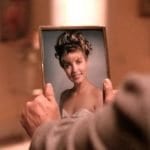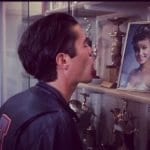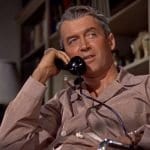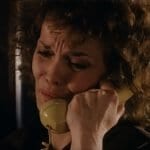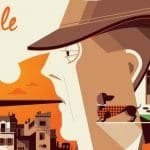Twin Peaks Backstory Investigations looks at the film and television that influenced David Lynch & Mark Frost when they created their wonderful and strange TV Show. For the third in the series, Andy Hageman takes a look at Alfred Hitchcocks, Rear Window.
In the “Heroes of Film” chapter of his 2007 book, Catching the Big Fish: Meditation, Consciousness, and Creativity David Lynch writes:
“I love Hitchcock. Rear Window’s a film that makes me crazy, in a good way. There’s such a coziness with James Stewart in one room, and it’s such a cool room, and the people who come into this room–Grace Kelly, for instance, and Thelma Ritter–it’s just so fantastic that they’re all in on a mystery that’s unfolding out their window. It’s magical and everybody who sees it feels that. It’s so nice to go back and visit that place.”
I think that last sentence of the quote captures a heartfelt sentiment shared by most Twin Peaks fans: so nice to back and visit that place! Of course, there’s always a risk that a favorite cinematic work can turn into a mere source of cozy comfort and/or an unreflecting nostalgia for one’s early encounter with the series. One way to maintain the liveliness of returns to Twin Peaks is by juxtaposing it with the most frequently cited cinema inspirations of its creators. It’s a mental exercise both critical and creative to run Twin Peaks and another film, in this case Rear Window, like a montage to see what bubbles up.
Rear Window is a film I rewatch at least once a year as I teach it regularly in an Introduction to Film course, but, honestly, I’d rewatch it at that cadence even if I wasn’t teaching it. Part of what makes Rear Window eminently rewarding to the return spectator is its blend of the familiar with seemingly endless new stuff to notice. I say “stuff” because one of the real sources of liveliness in the film is the mise-en-scene of L.B. Jeffries’s (James Stewart)—who I’ll refer to as Jeff—apartment. The accoutrements of Jeff’s life line the walls, shelves, and tabletops of his apartment. They communicate to the spectator.
And on my return just days ago to Rear Window for this article I thought of the parallel between these objects and something Peter Ackroyd mentions in his biography of Alfred Hitchcock. Ackroyd asserts that this film feels like a return to Hitchcock’s silent film days because Jeff, and vicariously the spectator, is unable to hear into the apartments where he is able to peer. One conclusion to draw from this assertion would be to equate the neighbors with the knick knacks in Jeff’s home—objectified objects. But I think there’s another, more persuasive, conclusion, that the parallel, in fact, de-objectifies, I’d say vivifies, the knick knacks. The mise-en-scene possesses animated energy and mystery, and Twin Peaks accomplishes this wonderfully as well.

The Twin Peaks pilot and Rear Window both present objects of personal decor in their openings. In the film, this clearly serves the role of exposition. In just a few short minutes, Hitchcock fills the spectator in on who Jeff is by what he owns and how he displays it to depict himself to guests and on why Jeff’s leg is in a cast, all in a meandering camera mode that syncs the expository content with the formal focus on voyeurism. Other Twin Peaks fans have also noticed that one of the framed photo prints on display is the mushroom from an atomic bomb explosion—a link to Gordon Cole’s office decor in Season Three worth further consideration. The looky-loo camera completes its circuit of the apartment by showing that Jeff has framed the negative of Lisa Fremont (Grace Kelly), and it stands next to the positive image featured on the cover of a magazine. This double sets us up for Jeff’s declared frustration that Lisa’s too perfect and his professed revulsion at the idea of marriage. It also communicates the multiplicity of both Lisa and Jeff. He sees her two ways, at least, and he displays two contradictory images that he has made of her.
The two Lisa images continue to fascinate me, and I recommend replaying that opening bit several times to challenge yourself to keep probing the sophisticated messages these vibrant objects activate. To do so is worth it on its own terms, but for Twin Peaks fans, this analytical exercise can reframe what you make of the various homecoming queen photo prints of Laura Palmer—from Leland’s dance with it to Bobby’s kiss separated by trophy case glass to Sarah’s glitchy destruction of it in Part 17—as well as the black and white photo of Laura in the Palmer living room in the original seasons.
Beyond the photographs, analyzing the opening tour through Jeff’s apartment can bring new energy to the opening tour through Josie Packard’s bedroom at the start of the Twin Peaks pilot and to the decor-observant camera that moves through Agent Cooper’s hotel room at the Great Northern at the start of “Traces to Nowhere.” (Not to mention Sarah Palmer’s fireside bunnies, Leo and Shelley Johnson’s clown paintings and wall-flying geese, Nadine’s figurines, and so on).
I keep going back to Josie’s decoration choices, like the lamp in particular, and considering who chose to acquire the objects and where, why they chose to put them on display as part of the room/home, and what they communicate to Josie, to her visitors, and to the spectator? Was the lamp Andrew’s? If so, what did it say to him? And does Josie keep it to keep up the facade of a grieving widow or because it says something similar to the mastermind capacity she shares with Andrew? Or, if she acquired it after Andrew’s presumed death, what’s in the lamp of the new start? Then, in the case of Cooper, the furniture, art, and taxidermied animal hoof fixtures are pieces that inform his character rather than reflect it. Formally, the spectator joins the camera in a Rear Window move, but unlike in Hitchcock’s film, this gaze is something Cooper would do, too, as he tries to get a read on the town of Twin Peaks. In place of investigating a character through their expository decor, we join a character in investigating the character of the locale through expository decor. Familiar, but with a twist.
In Rear Window the sheer volume of objects in the mise-en-scene permeates the whole film. Subsequent scenes put new areas of the apartment on display so that the seemingly ceremonial masks mounted on one wall come into focus for a time among other souvenirs. What the masks and many other objects in Jeff’s place convey is a life of extensive and exotic travel. Adventure and a sense of superficial anthropology, and all with an expression of middle-class positioning entirely distinct from the high society position that Lisa inhabits.
What I find fascinating about this self-representation is the emphasis on the global within a film that unfolds in a highly restricted geographic range. Jeff has traveled widely outside of the US and often in circumstances of civil unrest or fully-declared war. He lives a global life even when he’s confined to a middle-class life inside a small New York apartment. Lisa, too, is global, as that fab dress she wears on her initial visit to Jeff is fresh in from Paris. And at the close of the film, Lisa is reading, at least until Jeff falls asleep, Beyond the High Himalayas.
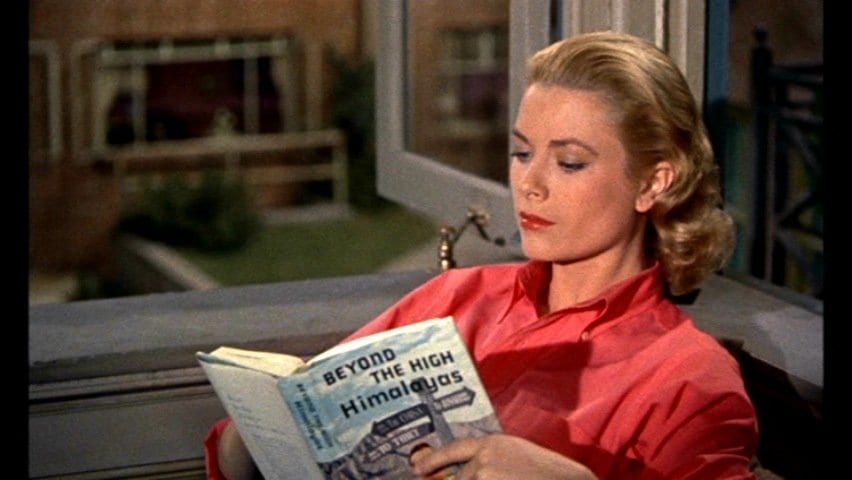
The use of objects to attune the spectator to the global in the apparently hyper-local can provoke new perspectives on Twin Peaks. Hong Kong, Japan, Norway, Iceland, France, Canada and more all converge in the town of Twin Peaks, shaping its economy and therefore shaping life in general. And let’s not forget Tibet, which Cooper introduces to contextualize his investigative rock-throwing technique. In fact, after that particular scene, Lucy Moran is later shown reading a book simply titled Tibet, in what can be read as a refraction, rather than straightforward reflection, of Lisa’s reading at the end of Rear Window. What they call repetition with a difference.
It’s also worth considering Jeff’s interest in the masks and other cultural artifacts in relation to the fact that the work of Sigmund Freud was running high in the US social imaginary at this point of the 1950s. Stella (Thelma Ritter), Jeff’s nurse, calls out psychoanalysis by name in an early scene. Freud’s Totem and Taboo—a book as captivating as it is warped—was in the early ’50s a theory under intense scrutiny by anthropologists and feminists like Simone de Beauvoir and therefore in the public eye. Freud’s theories in the book engage historical shifts in human understandings and actions regarding death, murder, family, and sex, and the book draws upon cultures outside of the western European milieu in which Freud had lived.
Without going into the details of Freud’s work, I want to emphasize that Jeff’s depiction of self is indubitably marked by a common zeitgeist. He’s a white western man traveling to sample cultures and discern meaning in his own life by turning others into instructive objects. And that’s important because one way to read Rear Window is the arc Jeff takes away from that objectifying approach to others. It’s also important because so much of Hitchcock’s film work was forged in the crucible of a culture where Freud loomed large. This is not to say that Hitchcock had Freud in mind as part of creative intentions. But. Intentional or not, Freud was in the water at the time so the films have Freud in them, and audiences in the 50s brought Freud in them, consciously or not, when they watched Rear Window on the big screen.
To apply this idea to Twin Peaks, it’d be revealing to think about what sort of public intellectual notions were influential in 1990-91 that the audience would’ve brought along when sitting before the TV set. Fredric Jameson’s Postmodernism among others I suspect, even if many of the media people who circulated the word/notion of postmodernism weren’t aware precisely who the intellectuals were behind the words and notions. Adjacent to postmodernism, I suspect Clement Greenberg on avant-garde and kitsch was still rippling the cultural surface to an extent that it would be worthwhile to take the essay by that name into an attentive viewing of Twin Peaks. Furthermore, I want to endorse the invocations of Freud as well as Jacques Lacan and the film critics who take psychoanalytic approaches when thinking through Twin Peaks. The objectives, frameworks, and tools that psychoanalysis offers to people who want to tangle with complicated stories make new things visible, and they don’t have to be deployed as total explanations of what a series or film mean.
Okay, I’ll finish this return to Rear Window with one more thought on the montage it makes when juxtaposed with Twin Peaks.
One is telephones. Recall that Ackroyd noted how Jeff can’t hear what’s happening in other apartments, but he can see. There’s a scene where Thorwald removes his wife’s handbag from a drawer and makes a telephone call. Jeff carefully scrutinizes the rotary dial and says aloud that he can tell Thorwald has made a long-distance call. Then, later in the film, Jeff makes a threatening call to Thorwald followed by a panicked call to Lt. Tom Doyle (Wendell Corey) for help. Immediately after replacing the receiver in the cradle atop the phone’s base, it rings and Jeff picks it up and without waiting for a word from the caller presumes it’s Doyle calling back and emphatically says to hurry because it looks like Thorwald’s going to run. Then, phone silence, and a hang up click. Jeff knows Thorwald has used the telephone to confirm that he’s the one who’s onto the murder. The long-distance line echoes in Lucy Moran explaining that she suspects an incoming call to the Sheriff Department is long-distance, in this case because “it has that open-air sound where it sounds like wind blowing, you know, like wind through the trees.” And that echoes through Lucy Brennan’s inability to grasp cellular telephone technologies. Not to mention the massive panoply of moods that get bundled with telephones across the three seasons of Twin Peaks—Sarah talking to Leland when Sheriff Truman arrives in the pilot, the elderly waiter hanging up on Deputy Andy in the Season 2 premier, the audio-tape faked call from Laura to Dr. Jacoby, Darya’s panicked hangup when Mr. C arrives at the hotel, and the list goes on and on. Telephones on film via Hitchcock and Lynch would be a fascinating cinema map to assemble and analyze.
Consider screening Rear Window with Twin Peaks in mind. See if you notice a moment when one of Albert’s crueler quips rehearses the way Jeff dismisses a bit of Stella’s wisdom, and see what you think Hitchcock and the bachelor composer are discussing while the director is winding a clock on the mantel for his cameo.


